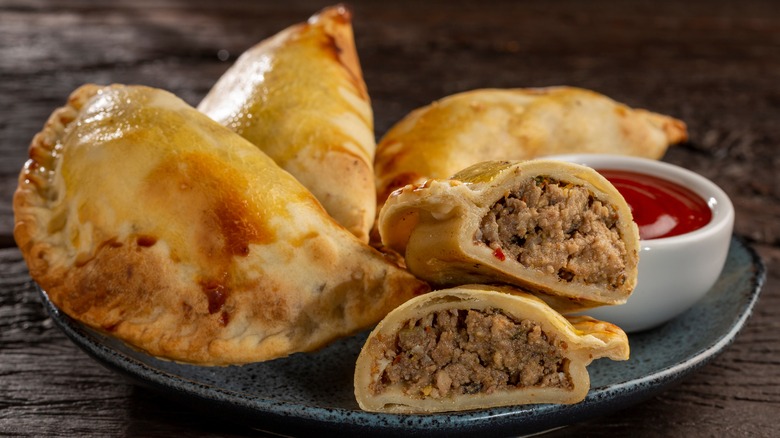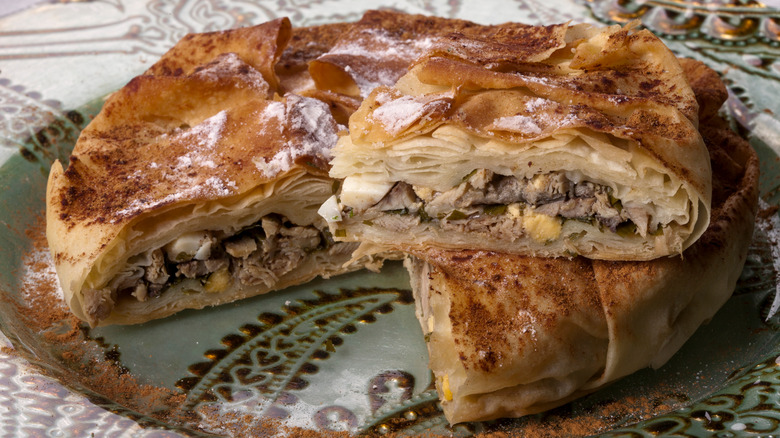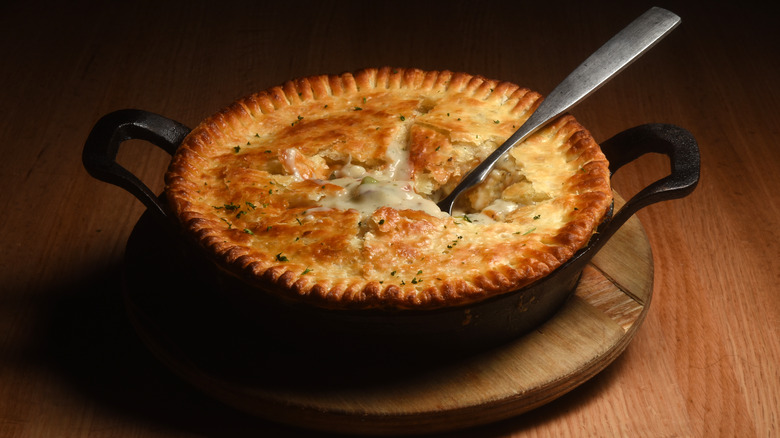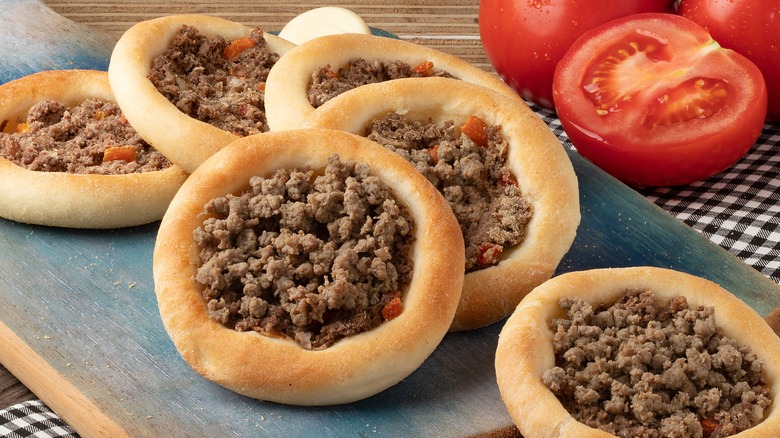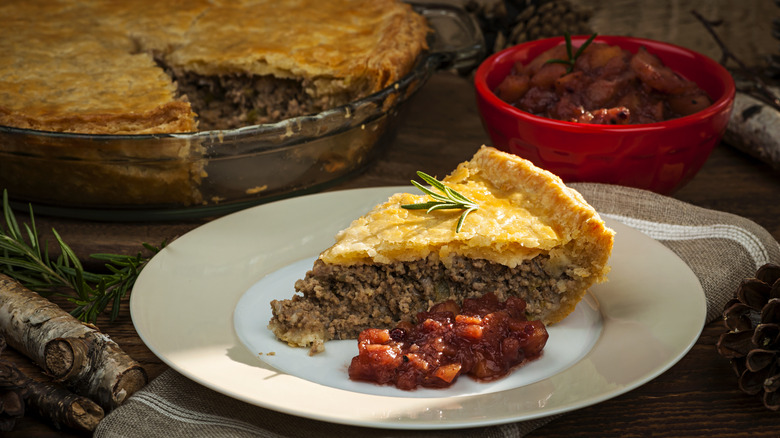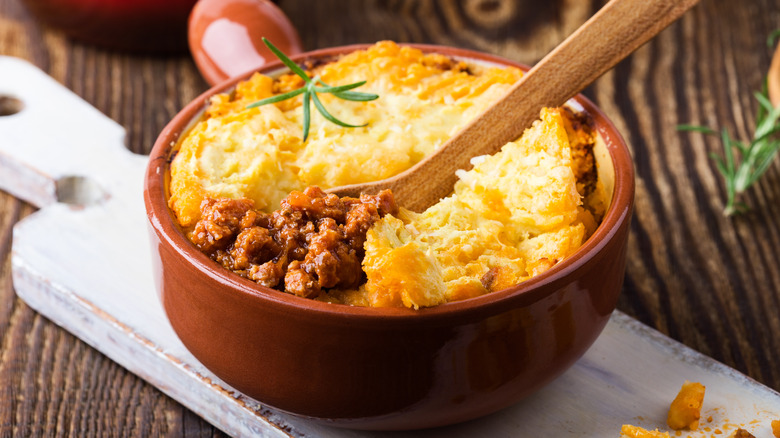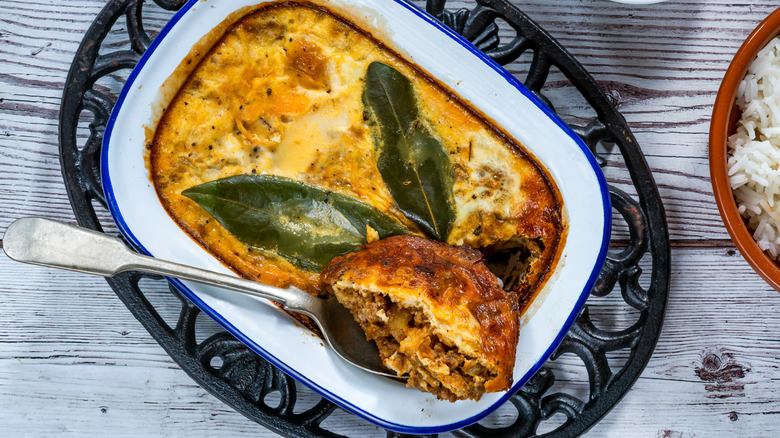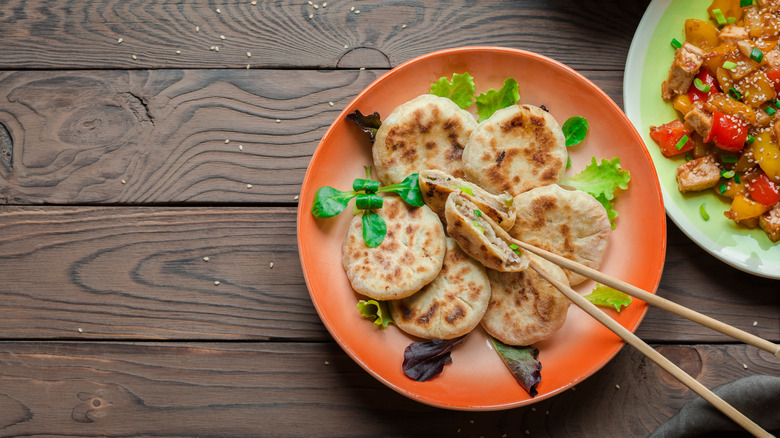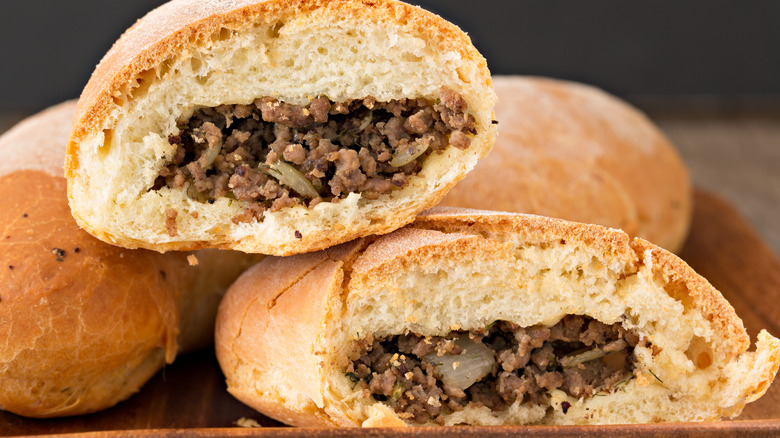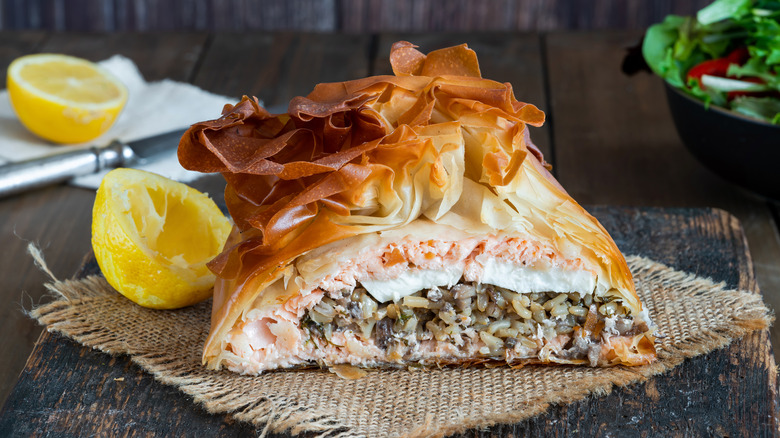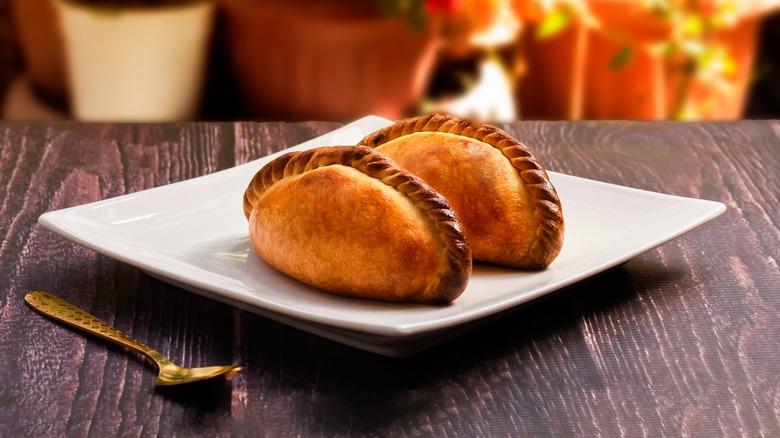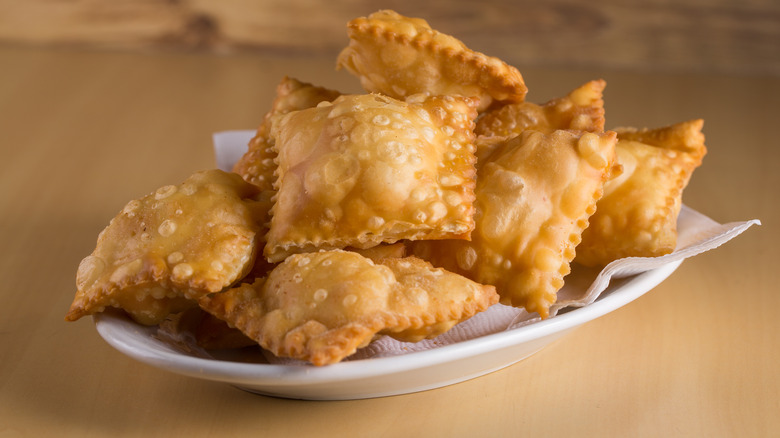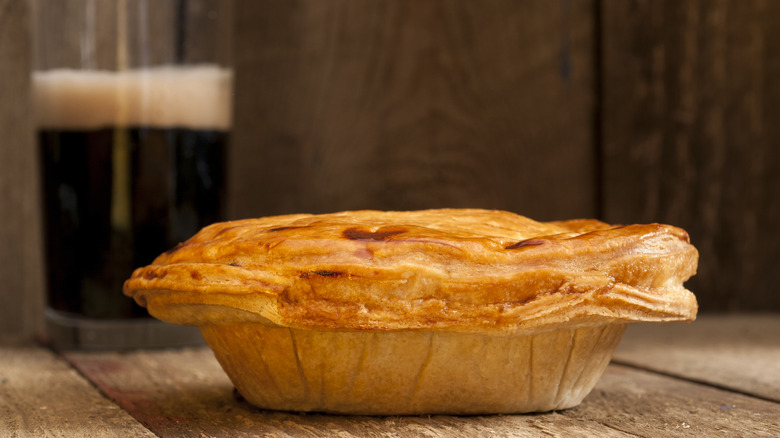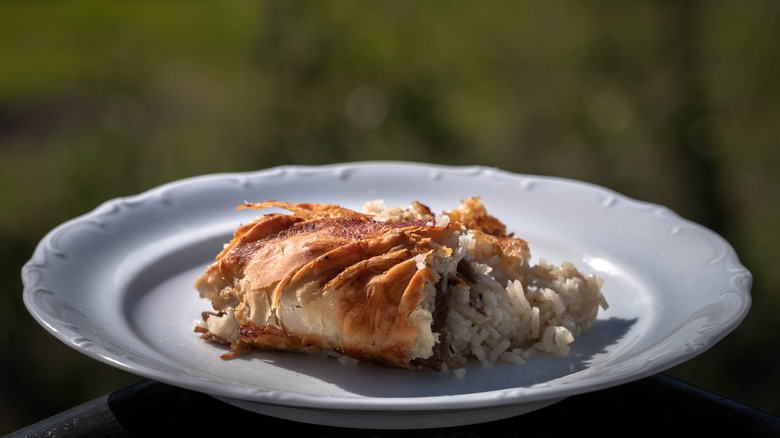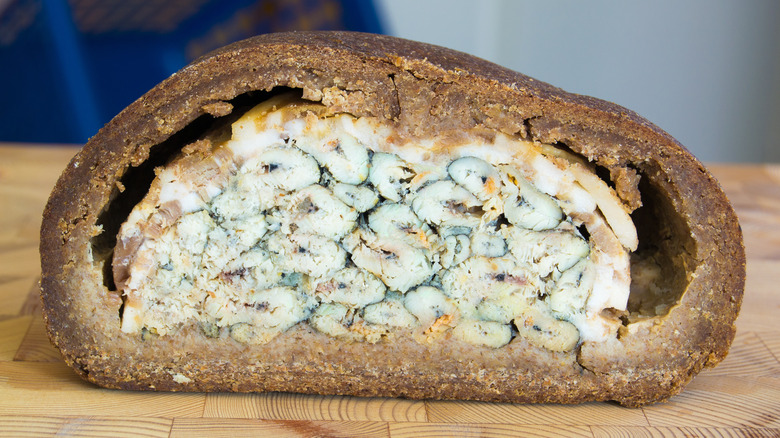15 Delicious Meat Pies Found Around The World
Throughout the world, savory meat pies are a way to enjoy a pastry outside the realm of dessert. While there is an iconic pie in every state and the dessert is a staple of American cuisine and pastry shops alike, meat pies are a different kind of delight. Typically, these dishes combine flaky pastry with a hearty filling of seasoned meats, vegetables, and aromatic spices. With such a variety of flavors, these pies sometimes create a balance between sweet and savory and can be enjoyed at any time of the day, for any meal, and as a snack, appetizer, or main course.
In some countries, their pastries won't look like a traditional pie, such as the shepherd's pie or chicken pot pie with which you may be more familiar. No matter the shape, almost every country has its own variation of a savory pie that embodies the culture and cuisine. From Spanish empanadas to Finnish kalakukko, here are 15 delicious meat pies you can find around the world.
1. Empanadas - Spain and South America
More of a turnover, empanadas are essentially little pockets of flaky dough that are usually filled with meat (think beef, chorizo, pork, or chicken), cheese, sometimes potatoes, and other vegetables. These pastries are very popular in Spain, Argentina, and throughout Latin American countries, and have even gained popularity in the United States. Like most hand pies, empanadas are stuffed and then baked until golden brown, resulting in a crispy dough with a filling of juicy, flavorful ingredients. Originally, the dough was made with animal fat due to the abundance of cattle, and since then, the flavors have only gotten more rich and more unique.
In Venezuela and Colombia, corn flour is used for the dough while in the Caribbean, yuca or plantain is used for the starch. Just as they can be versatile with the ingredients, empanadas can also be served as a snack, appetizer, or entrée.
In Argentina, there is a different empanada in every province of the country. For example, in Buenos Aires, they are typically filled with ground or minced beef, chicken, or sometimes ham and cheese. Salsa blanca, an Argentinian sauce somewhat like Béchamel, is often served on the side. Whereas an empanada from Catamarca, a northern province, will likely be filled with (among other ingredients) goat meat, potato, onion, paprika, and a diced hard-boiled egg.
2. Pastilla - Morocco
In Morocco, the quintessential meat pie is the pastilla, also called bastilla. This dish combines savory and sweet flavors like chicken or cornish hen, almonds, and cinnamon and sugar enveloped in layers of thin dough called warka (or warqa), which is somewhat similar to filo pastry. Traditionally, this pie calls for very tender, juicy poultry and in the Fez region of Morocco, the classic bastilla is stuffed with pigeon, almonds, and spices like saffron and cinnamon.
In general, the process is rather meticulous, and sometimes the filling is prepared a day beforehand, partly because making the warka requires a practiced hand, and also because the filling is arranged in layers between the thin dough. The first layer consists of the seasoned poultry, the next layer is an egg mixture, and the final layers incorporate the ground and toasted almonds, and finished with a lattice decoration made of cinnamon and sugar.
3. Chicken pot pie - USA
You're likely familiar with this true American classic — the chicken pot pie. In fact, it's now such a popular part of American cuisine that frozen pot pies can be found in grocery stores all over the country. Like a dessert pie, chicken pot pie uses a traditional pie crust (frozen or handmade — your pick!) that is filled with various ingredients and baked to golden perfection. While there is flexibility among recipes, most fillings call for chicken and vegetables such as carrots, onions, peas, celery, and potatoes, all swimming in a sumptuous broth. It's one of those pantry pies that are great for making with whatever you have on hand.
The pot pie itself has a long history dating back to the Roman Empire, where they deviated on the Greek dish, artocreas, by adding a top crust to the meat-filled pastry shells (and they also apparently used live birds). And, in Elizabethan England, they used little chicks stuffed with gooseberries, called "chicken peepers", in the filling. Since then, Americans have expanded on the original methods and perhaps calmed them down a little from the days of hiding live birds under the top crust. Now, however, the chicken pot pie is the ultimate American comfort food and a culinary classic.
4. Sfiha - Lebanon
Sfiha (or sfeeha), sometimes also called Arabic pizza, is a Middle Eastern dish that hails from the Levant region of Asia. This meat pie is made with flatbread and topped with ground beef or lamb, onion, tomatoes, pine nuts, and spices. When compared to other meat pies, sfihas stand apart because of the aromatic spices used, such as garlic, allspice, cumin, cinnamon, and parsley. Another reason these pies are so delicious is because they call for fatty meats to enhance the overall flavor.
The empanada might have even originated from the Arabic sfeeha after being brought to northern Spain and Portugal when Moors from the Arabian peninsula moved into Spain and Portugal around the early 8th century. Yet while the Middle Eastern dish is comparable to the empanada, its dough is much more like that of pizza. Plus, it isn't stuffed full (like an empanada) as it is smothered in toppings, and then baked.
5. Tourtière - Canada
Often enjoyed on Christmas Eve, tourtière is a Québecois flaky, double-crusted pie that holds a filling of ground pork, veal or beef, sometimes potatoes or vegetables, and bold spices. Different recipes exist among different communities — some use a combination of meat, some stick to pork, and some utilize local wild game like rabbit or moose. The assembly can also vary — it can be a shallow pie filled with meat and spices, or it can be a multi-layered pie.
What is certain is that some of the first recipes for tourtière were written back in 1840 in the cookbook, "La Cuisinière Canadienne," branding it as a French Canadian classic. Furthermore, this dish is all about the meat. Oftentimes, vegetables are omitted, leaving only richly seasoned meat to make up most of the pie. While tourtière is commonly known as a holiday course, it doesn't stop residents from enjoying this pie on the regular, which can now be purchased as a frozen pie in Canada from supermarkets and grocery stores such as Walmart.
6. Shepherd's pie - United Kingdom
Also called cottage pie, shepherd's pie is a dish often served in the U.K. but it's actually of Irish origin. This meat pie most usually has a filling of ground lamb or beef, with various other ingredients like onions, peas, carrots, garlic, tomato puree, cheese, herbs, and spices. While recipes differ, the structure always consists of a minced meat and veggie filling and a top crust of mashed potatoes. Its name, cottage pie or shepherd's pie, depends on the meat — the latter is typically made with mutton or lamb and the former uses beef.
Originally, these meat pies were a way to eliminate food waste and make an inexpensive meal. By the 1700s, potatoes were an inexpensive ingredient in Ireland, so incorporating them into a pie with other staples came naturally. The divide between the Irish dish and the British dish also comes down to the name and ingredients. Cottage pie was the name used for both lamb or beef-filled dishes until around the mid-1800s when the name shepherd's pie was attributed to the lamb filling. Whichever name or meat you use, this dish has maintained its prominence in U.K. cuisine and is delicious with whatever filling you choose.
7. Bobotie - South Africa
A traditional South African bobotie is not unlike other meat pies, except that it is often served with dried raisins in addition to its filling of minced meat and spices. In the case of bobotie, the spices come in the form of curry powder with bay leaves, and the pie is topped with an egg and milk mixture. The word "bobotie" has indefinite origins — it could stem from the Malayan "Boemboe", meaning "curry spices", or the Indonesian "bobotok", alluding to the dish that is made of meat topped with custard.
This colorful and unique dish has been compared to both casserole and meatloaf, but it fits the bill for meat pie because of its hearty, spiced filling and its custard-like topping, which acts as a lid. What makes bobotie such a distinct dish is that it's not just a focus on the meat — this South African classic is proudly spiced, complemented with zingy flavors of fruit chutney (remember the aforementioned raisins?), and served alongside basmati rice with a dash of sambal ( a chile paste), an Indonesian chili pepper sauce.
8. Xian bing - China
China's version of a meat pie, called a xian bing, is a pocket of dough filled with staples of Chinese cuisine like beef or pork, scallion, onions, soy sauce, sesame oil, and pepper. Among the spices are sweet flavors, like brown sugar and ginger, which complement the spicy and savory notes of this dish. Although it's more of a pan-fried dumpling with a crispy crust, xian bing has also been compared to pot stickers or hand pies; when you look at them, you might even think of empanadas. Like most pies, xian bing is considered a comfort food and can be found at street vendors and restaurants alike. In some regions, the traditional recipe varies from a different protein like lamb to fully vegetarian versions.
In Chinese cuisine, "bing" refers to "bread" and can take many forms – flatbread, pancakes, cakes, dumplings, pies — but a Chinese bing, a flatbread without filling, is not the same as xian bing, which is a loose translation of "meat pie". Even though this dish may not look like a meat pie, the process of cooking it and its comfort food factor makes it close enough for us!
9. Pirozhki - Russia
From the world of hand pies comes the Russian and Ukrainian pirozhki. Unlike most pies or pasties, pirozhki is made with a fluffy, yeast dough that can be stuffed with either sweet or savory ingredients. Some savory fillings typically found in pirozhki are ground meat, cabbage, mashed potatoes, liver, spring onions, or eggs. The pirozhki is like a small turnover or stuffed bun with a soft dough and crispy, buttery exterior but shouldn't be confused with the slightly more prevalent Polish pierogi (which is a dumpling cooked in boiling water). This street food is meant to be eaten in a few bites, which to us just means it's a small package that packs a big, flavorful punch.
Back in the 1950s, there was actually quite a battle contesting its origins. A Japanese chef, Hazuo Tomita, ended up patenting pirozhki as his own invention, leading to a court battle that garnered 600 witnesses to testify that the recipe was indeed of Russian origins. Even today, the finger food can be bought in Japan, but it remains an eminent fast food option throughout Eastern Europe.
10. Coulibiac - France
Coulibiac is the French version of the Russian dish, kulebiaka, and consists of a pastry crust with a filling that typically has salmon accompanied by various other dishes like rice, mushrooms, dill, shallots, or hardboiled eggs. Originally, the Russian recipe used sturgeon instead of salmon and buckwheat instead of rice. When the French took hold of the dish, the recipe and name changed. Well, actually, it was Julia Child in 1978 who officially changed the name to "choulibiac" after she adapted a recipe from the infamous French chef Auguste Escoffier. He had learned the Russian recipe when serving Russian navy officers at his uncle's restaurant in Nice and then shared the recipe in his book, Le Guide Culinaire.
Since this meat pie boasts a full meal in a crust, it requires several tedious steps. Not only do you have to poach the salmon, but you also have to individually prepare each additional filling, such as the rice and vegetables. All of this in addition to laying out the puff pastry and layers of crepe to assemble the pie. Despite being a lot of work, this savory dish is worth it — with two French experts as driving forces behind the revamped recipe, we're hardly surprised.
11. Salteñas - Bolivia
Out of Bolivia come baked hand pies called salteñas, which are meat-filled pies not so much unlike an empanada or dumpling, but with a certain ingredient that sets them apart: gelatin. Seasonings like oregano and bay leaves and peppers like aji panca can accompany the traditional recipe, with a stuffing that calls for a stew of ingredients like beef or chicken, potatoes, onions, peas, and raisins all swimming together in gelatin that creates a broth inside the pastry. Sometimes, there is an olive or hard-boiled egg tucked away in the pastry as a little surprise when you take a bite.
Unlike empanadas, salteñas have a fairly unwavering and time-consuming process. To achieve the broth filling, add gelatin to the wet mix until it starts to set and thicken. Then place it in a hot oven, which will melt the gelatin mixture back into liquid where it will wait to burst from inside the cooked pastry. Before gelatin was used to speed things up, the traditional method was to simmer chicken feet or beef marrow bones until you started to pull collagen which would help set the filling. You can find salteñerías throughout Bolivia, shops where they are made and served.
12. Pastel de carne - South America
Pastel de carne comes goes by a couple fo different names — pastelitos de carne in Cuba, pastelillos de carne in Puerto Rico, and pastel de carne throughout much of South American cuisine. These meat-filled pastries are traditional in Spanish cuisine, despite not being solely from Spain. Like empanadas, pastels are thought to have originated in Galicia, but some say it was Cuba where pastelitos were first seen. While they do resemble the Spanish empanada, the shape varies. Pastelitos de carne can look almost like stuffed biscuits, or they can be flakier, with layers of thin pastry that have been crimped before being fried, or they can look more like fried ravioli than turnovers.
When it comes to the filling, every play on pastel de carne involves much of the same: ground meat, peppers, onion, garlic, olives, and some sort of spicy sauce or sazon to intensify the flavor. Furthermore, while empanadas can be baked, deep-fried, or even cooked on a grill or griddle, an authentic pastel de carne is almost exclusively fried. Just like its predecessors and accompaniments, this savory snack is typically found in markets and at street vendors as a delicious to-go food option.
13. Beef and Guinness pie - Ireland
You've got your classic mutton pies, pot pies, and cottage pies, and then there's the beef (or steak) and Guinness pie that's a staple of Irish cuisine. With its roots embedded in the traditional steak and ale pies of Europe, Ireland's dish is dependent on Guinness stew. Stewing meat has long been an efficient method of cooking because it's relatively inexpensive to make, combines ingredients you have on hand, and can easily be prepped and saved. Before beef became readily accessible in Ireland, mutton or lamb were the prime choices for a stew, plus other foods like potatoes, barley, and onions. By the time Irish-Americans were creating this dish in more recent times, beef and steak were available in markets.
As far as the Guinness; yes, it's talking about the beer. Ireland has been brewing the infamous black stout beer since 1759, and it was a normal addition to an Irish diet. Since the ale was also great for tenderizing meat, think of it as two birds, one stone. To make this Irish pie, you just need to make a gravy-like stew from the beer, beef, and vegetables, and bake it in a crust topped with pastry.
14. Kreatopita - Greece
Greek cuisine is full of pastries — hortopita, spanakopita, tyropita, and baklava, to name a few — and kreatopita is the country's version of traditional meat pie, native to Kefalonia. Like most Greek pastries, this rustic pie uses flaky phyllo dough, but an authentic kreatopita requires two different kinds of meat. Any combination of veal, lamb, pork, or beef works; then you add vegetables like sautéed leeks, onions, tomatoes (or tomato paste); and then rice, and sometimes feta, to emphasize the robustness of the dish.
If you've ever worked with phyllo dough, you know it can be a painstaking affair. Authentic recipes call for this tricky pastry dough, but this meat pie can technically be assembled with puff pastry. Either way, you go about it, you start by layering the dough at the bottom of a pan like with most pies, filling it with the seasoned meat and vegetable mixture, and covering the top with more layers of the dough, sealing everything snugly inside.
15. Kalakukko - Finland
In Finnish, "kala" means "fish" and in Karelian, the Finnic language spoken in different areas of the country, "kukko" means "pie". So kalakukko quite literally translates as "fish pie" despite actually being a rye bread crust with a filling typically comprised of bacon-wrapped fish. Kalakukko is an early version of street food and was often toted around town with a wooden handle to serve as a way to enjoy the snack while on the move.
Traditionally, kalakukko is made with a type of lake fish found in Finland, called vendace. This delicate fish is related to salmon and has a rich flavor. Today, recipes sometimes substitute salmon, perch, or smelt instead of the local vendace. No matter the fish, this pie comes with specific instructions that involve laying strips of raw bacon over the fish and carefully forming the bread dough around the stuffing before baking it. As it cooks, the bacon fat melts over the fish, resulting in a salty, briny flavor. Making and molding the dough correctly around the meat is no easy feat, and baking it is another challenge. If the crust is too thick, you risk underbaking it or causing a hassle while eating it; and if the crust is too thin it could overcook and dry out the delicate fish inside. If you're lucky enough to prepare, or just try, the finished masterpiece, it's a savory delight.

